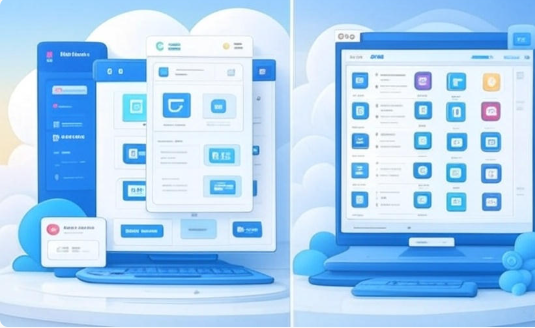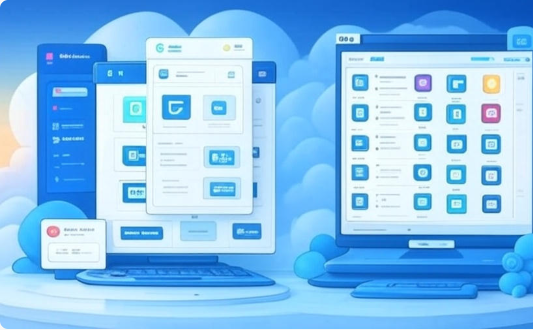In today’s fast-evolving digital landscape, choosing the right software solution is critical for business success. As companies increasingly rely on technology to improve efficiency, collaboration, and innovation, the debate between Software as a Service (SaaS) and traditional software solutions has gained significant traction. Understanding the benefits of using SaaS vs traditional software can help organizations make informed decisions aligned with their operational needs and growth goals.
This article provides a detailed comparison of SaaS and traditional software, highlighting key benefits, limitations, and the factors businesses should consider when selecting their software platform. Whether you’re a startup, an established enterprise, or somewhere in between, this guide will help you navigate the complex software landscape and choose the best fit for your organization.
What Is SaaS and What Is Traditional Software?
Before diving into the benefits, it’s important to clarify what SaaS and traditional software mean in practical terms.
Software as a Service (SaaS)
SaaS refers to cloud-based software solutions delivered over the internet. Instead of purchasing software outright, users subscribe to a service model where the application is hosted on the vendor’s servers and accessed remotely via web browsers or dedicated apps.
Key characteristics of SaaS include:
-
Subscription-based pricing (monthly or annual)
-
No need for local installation or infrastructure
-
Automatic updates and maintenance managed by the provider
-
Accessibility from any device with internet connectivity
Popular SaaS examples include Google Workspace, Salesforce, Dropbox, and Slack.
Traditional Software
Traditional software (also called on-premise software) is installed locally on a user’s computer or company servers. It often involves a one-time purchase or license and requires manual installation, configuration, and ongoing maintenance by the company’s IT staff.
Characteristics of traditional software include:
-
Upfront licensing or purchase cost
-
Local storage of software and data
-
Manual upgrades and patches required
-
Usage typically limited to specific devices or locations
Examples include legacy ERP systems, desktop-based accounting software, and traditional productivity suites installed on computers.
Key Benefits of Using SaaS vs Traditional Software
Businesses today are increasingly opting for SaaS solutions due to numerous advantages. Below, we explore the most significant benefits of SaaS compared to traditional software.
1. Cost Efficiency and Lower Upfront Investment
One of the most compelling benefits of using SaaS vs traditional software is the cost structure. SaaS typically operates on a subscription or pay-as-you-go model, eliminating large upfront license fees and hardware expenses.
-
Traditional Software: Usually requires a significant initial investment for software licenses, servers, and infrastructure. Additionally, companies incur ongoing costs for IT support, maintenance, and upgrades.
-
SaaS: Costs are spread out over time, making it easier for businesses, especially startups and SMBs, to manage budgets. The vendor handles infrastructure, reducing the need for in-house hardware and personnel.
This pay-as-you-go model enables businesses to avoid capital expenditures and convert software spending into a predictable operational expense.
2. Rapid Deployment and Easy Scalability
SaaS solutions are ready to use almost immediately after subscription, allowing businesses to deploy software quickly and respond rapidly to changing needs.
-
Traditional Software: Deployment can be time-consuming, requiring hardware installation, configuration, and testing, which may delay project timelines. Scaling the software for new users or functionalities often involves additional hardware purchases and complex setups.
-
SaaS: Since the software is cloud-hosted, users can scale up or down effortlessly by adjusting their subscription plans. Adding new users or features is typically done with a few clicks and no hardware changes.
This flexibility supports business growth and seasonal fluctuations without operational bottlenecks.
3. Accessibility and Remote Collaboration
With more businesses embracing remote work and global teams, accessibility is a critical factor.
-
Traditional Software: Often restricted to devices where it is installed. Remote access may require complex VPNs or remote desktop solutions, which can impact user experience and security.
-
SaaS: Accessible from any device with an internet connection and a browser, enabling seamless remote work and real-time collaboration. SaaS platforms often include built-in collaboration tools, such as shared document editing, chat, and notifications, fostering productivity across locations.
This accessibility aligns perfectly with today’s distributed workforce models.
4. Automatic Updates and Reduced Maintenance Burden
Keeping software updated is vital for security and performance.
-
Traditional Software: Updates and patches must be manually installed by IT staff, often leading to downtime and compatibility challenges. Many organizations delay updates due to resource constraints or fear of disruption.
-
SaaS: Providers manage all updates and maintenance automatically in the background. Users always have access to the latest features, security fixes, and compliance improvements without interruption.
This reduces the IT burden and ensures systems are always optimized and secure.
5. Enhanced Security and Compliance
Security is a top priority for any business managing sensitive data.
-
Traditional Software: Security is the responsibility of the company’s IT department, which must implement firewalls, backups, monitoring, and compliance protocols. This can be costly and complex, especially for smaller firms.
-
SaaS: Leading SaaS providers invest heavily in advanced security measures, including encryption, intrusion detection, multi-factor authentication, and compliance certifications (e.g., GDPR, HIPAA). Many SaaS vendors offer robust disaster recovery and data backup services.
While some companies have concerns about data control in the cloud, reputable SaaS providers often surpass the security levels achievable with traditional setups.
6. Seamless Integration and Innovation
Modern businesses rely on a suite of tools that need to work together efficiently.
-
Traditional Software: Integrations can be complex, costly, and inflexible, especially with legacy systems. Upgrading or changing one tool may require adjustments across the IT landscape.
-
SaaS: Most SaaS platforms offer APIs and native integrations with popular business tools, enabling seamless data exchange and workflow automation. Frequent updates introduce new features and enhancements quickly, keeping companies at the forefront of innovation.
This interconnected ecosystem supports digital transformation initiatives.
When Might Traditional Software Be the Right Choice?
Despite the many advantages of SaaS, traditional software still has relevant use cases.
1. Industry-Specific Regulatory Requirements
Some industries (e.g., banking, government, healthcare) require strict control over data residency and compliance that may be difficult to achieve with cloud solutions. On-premise software allows complete control over infrastructure and data, satisfying legal and audit demands.
2. Limited or Unreliable Internet Access
Businesses in regions with poor internet connectivity or facilities operating in remote locations may struggle with cloud dependence. Traditional software enables uninterrupted work without reliance on internet availability.
3. Highly Customized or Legacy Systems
Companies with deeply integrated legacy systems or highly customized workflows may find transitioning to SaaS challenging. Traditional software allows for tailored development and control over system behavior.
4. Cost Considerations for Long-Term Use
While SaaS reduces upfront costs, subscription fees accumulate over time. For stable businesses with predictable software needs, owning traditional software outright can be more economical in the long run.
Cost-Benefit Comparison: SaaS vs Traditional Software
Factor |
SaaS |
Traditional Software |
|---|---|---|
Initial Investment |
Low, subscription-based |
High, upfront license & hardware |
Maintenance & Upgrades |
Included, automatic |
Manual, requires IT resources |
Deployment Speed |
Fast, almost immediate |
Slow, complex installation |
Scalability |
Easy, flexible subscription changes |
Difficult, requires hardware upgrade |
Accessibility |
Anywhere with internet |
Limited to installed devices |
Security |
Vendor-managed, advanced |
Company-managed, variable quality |
Customization |
Limited to vendor’s offerings |
Highly customizable |
Long-term Cost |
Subscription fees ongoing |
One-time cost, potentially lower long-term |
Future Trends Driving SaaS Adoption
The digital transformation wave shows no sign of slowing. More companies are moving to cloud-based SaaS models due to the following trends:
-
Increased Remote Work: The global shift toward remote and hybrid workforces requires accessible cloud software.
-
Cloud Infrastructure Maturity: Improvements in cloud security, speed, and reliability reduce previous barriers.
-
Integration with AI and Automation: SaaS providers rapidly adopt AI-powered features for analytics, customer service, and workflow automation.
-
Growing Ecosystem: SaaS solutions increasingly offer marketplaces, APIs, and plug-ins, enriching user capabilities.
-
Cost Optimization Pressure: Businesses seek flexible spending models amid economic uncertainties.
Frequently Asked Questions (FAQs)
What are the main benefits of using SaaS over traditional software?
SaaS offers lower upfront costs, faster deployment, easier scalability, remote accessibility, automatic updates, enhanced security managed by vendors, and seamless integration capabilities.
Is SaaS always cheaper than traditional software?
Not necessarily. SaaS lowers initial expenses but incurs ongoing subscription fees. Traditional software may be more cost-effective long-term if usage is stable and IT support is affordable.
Can SaaS solutions be secure for sensitive data?
Yes. Many SaaS providers comply with industry standards (e.g., GDPR, HIPAA) and invest in strong security infrastructures. However, businesses must assess providers’ certifications and data handling policies.
What if my business has poor internet connectivity?
Traditional software may be preferable if reliable internet access is an issue since SaaS requires continuous connectivity.
How easy is it to switch from traditional software to SaaS?
The switch depends on data migration complexity, customizations, and user training. Many SaaS vendors offer migration support to ease the transition.
Conclusion
Choosing between SaaS and traditional software is a strategic decision that impacts a company’s operational agility, costs, and technological competitiveness. The benefits of using SaaS vs traditional software are compelling: cost efficiency, rapid deployment, accessibility, automatic updates, strong security, and innovation readiness position SaaS as the preferred choice for most modern businesses.
That said, traditional software remains relevant in specific scenarios requiring maximum control, offline capability, or specialized customization. A thorough assessment of your business needs, regulatory environment, IT resources, and growth plans will help you select the software model that delivers maximum value.
As digital transformation continues to reshape industries, embracing SaaS can future-proof your operations and empower your workforce with the tools needed for success in an increasingly connected world. If you need assistance selecting the right software or want to explore SaaS solutions tailored to your industry, feel free to reach out. The right software choice can be the catalyst for your next phase of growth.












